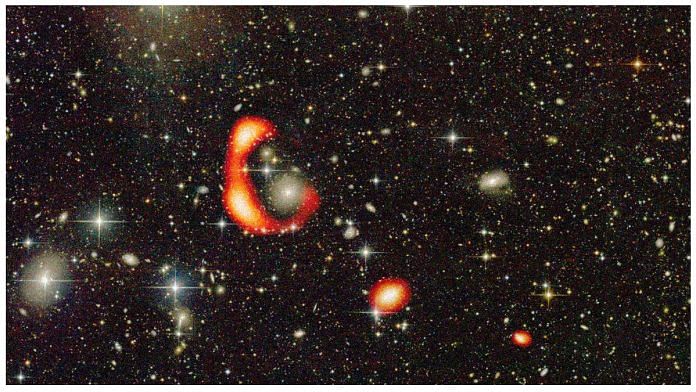New Delhi: A team led by Indian astronomers has spotted a gigantic, mysterious ring of hydrogen gas around a galaxy located about 260 million light-years away from Earth.
Using the Giant Metrewave Radio Telescope (GMRT), researchers from the National Centre for Radio Astrophysics (NCRA) in Pune, Maharashtra, found that the ring of hydrogen is much bigger than the galaxy that it surrounds, which is named AGC 203001.
With a diameter of about 3,80,000 light-years, the ring is about four times the size of the Milky Way, which contains our solar system.
Large reservoirs of neutral hydrogen gas are found in galaxies that are actively forming new stars. However, the galaxy AGC 203001 showed no signs of star formation, the researchers said in a statement.
“Usually in galaxies, you have a lot of gas in the form of hydrogen and lots of stars. If there is a lot of gas around a galaxy, it should also have a lot of active stars, since it is the gas that condenses into stars,” Omkar Bait, a PhD student at NCRA who was a part of the team, told ThePrint.
“But we found that this galaxy had no signs of new star formation,” he said.
Also read: New 3D map shows Milky Way isn’t shaped like pancake but a warped wave
The nature of hydrogen gas
Bait said that initially, the observations were made using a single dish telescope, which only reveals the mass of the gas and not its distribution.
But the unusual nature of this galaxy motivated NCRA researchers to use the GMRT to conduct high-resolution radio observations to find out where in the galaxy this hydrogen gas lies.
Neutral hydrogen emits radio waves at a wavelength of about 21 cm, which allows radio astronomers to map the amount and distribution of neutral hydrogen gas in the cosmos.
“GMRT has sufficient resolution to tell us how this gas is distributed. We imaged this galaxy with radiofrequency and what we found is that it is unlike usual galaxies where the hydrogen gas is within the optical extent of the galaxy — which means that the blob of gas would be on top of the galaxy,” Bait said.
For the galaxy AGC 203001, the researchers found that the neutral hydrogen is distributed in the form of a large off-centred ring extending much beyond its optical extent.
“You can see that the hydrogen (seen in red in the image above) spans much beyond the galaxy in the centre. This configuration is very rare,” Bait added.
The existing optical images of the ring showed no sign of new star formation in the galaxy.
In collaboration with two French astronomers, Pierre-Alain Duc and Jean-Charles Cuillandre, the team obtained a very sensitive optical image of this system using the Canada-France-Hawaii-Telescope (CFHT) in Hawaii, USA.
However, even these images do not show any sign of starlight associated with the hydrogen ring.
“The classical explanation to the formation of such off-centred rings around galaxies in astrophysics is that it is the result of a high-speed collision with some other galaxy — which pushed the gas out of the galaxy. However, if that was the case we should have seen active star formation within the galaxy,” Bait said.
What may have caused this hydrogen ring
The team has a couple of ideas on what may have caused this ring of hydrogen. One is that another galaxy may have passed through AGC 203001 and left a trail of gas in the form of an arc, Bait explained.
“Another explanation is that two galaxies (may have) merged together, and the gas got completely pushed out and then started falling back towards the galaxy in this ring-like configuration,” he said.
The team is now conducting a survey to map the neutral hydrogen around several more similar galaxies.
“We have observed nine more such objects with the GMRT in the last 6 months, and the data is being analysed,” Bait said.
The research should help better understand the formation mechanism behind such rare rings.
Also read: Astronomers spot flares travelling at 30% the speed of light outside Milky Way black hole



